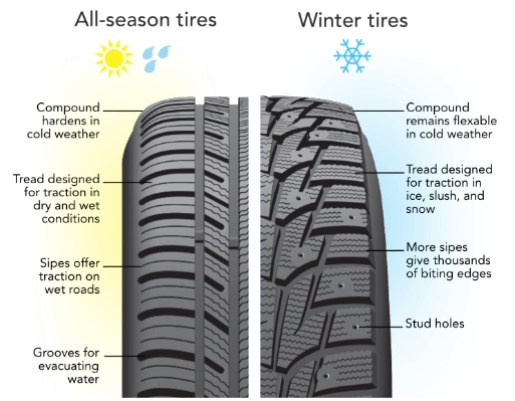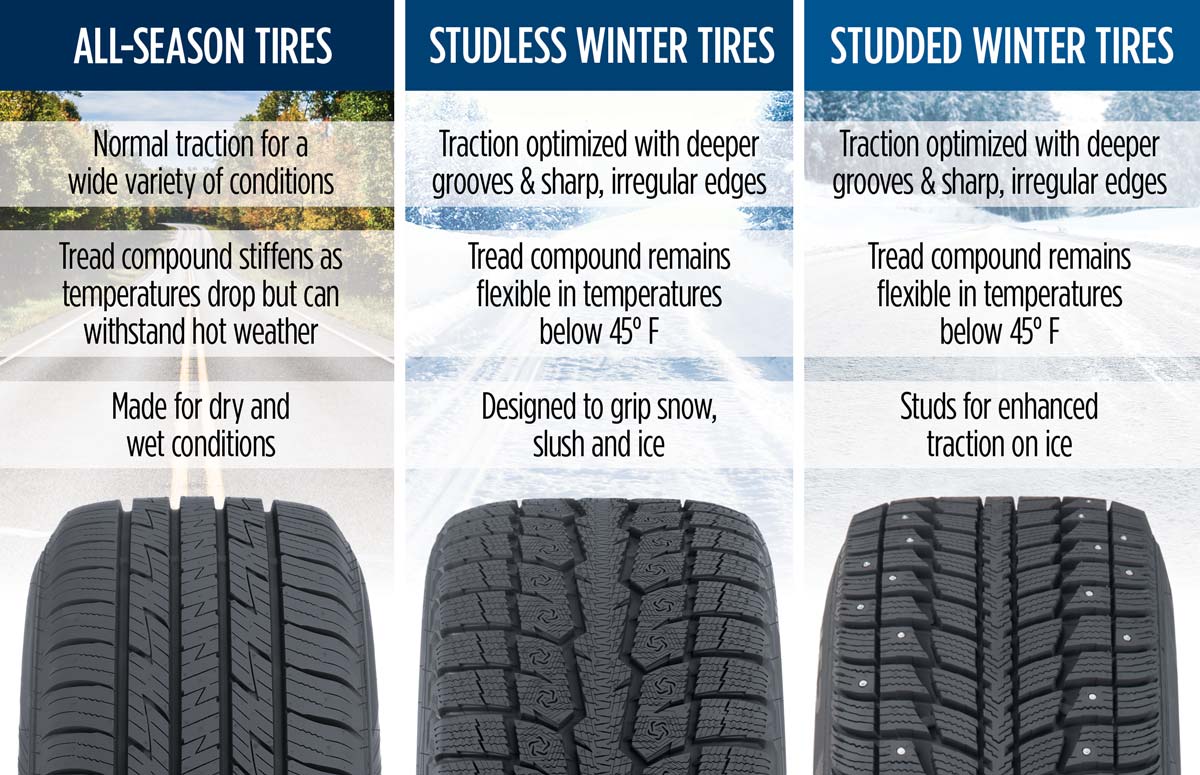Automotive: Pros and Cons of All-Season Tires
All-season tires are those which are made to use in any weather condition. Many people wonder what the best type of tire to buy is, whether it be all-season, summer, or winter tires. This article analyzes the pros and cons of all-season tires to help make the most informed decision possible.
What Are All-Season Tires?
All-season tires (Sometimes called Demi-Season tires) have great traction, which means the tire will offer a good grip for driving in snowy, icy, and muddy conditions. Most all-season tires are built using advanced polyester cords and will be equipped with sipes that channel water away from the tread to minimize hydroplaning. A sipe is a tiny slit on the tire’s surface. Tire siping is when extra slits are cut into a tire’s tread to boost traction. They often feature a strong center rib to counterbalance heavy snow and ice loads.
Tires won’t perform well if they don’t have enough tread, so they should be designed with lower tire pressures than summer or winter-rated tires. However, they can last even longer than other tires if properly maintained.

How All Season Tires Work
The all-season tires have deeper tread patterns, and they tend to be more flexible than the typical winter or summer tire. An All-season tire has a tread pattern that is a good blend between sportiness, fuel economy, and durability, plus some features like deep grooves and blocks, which improve handling in light snow conditions.
They are designed to provide surefooted traction on dry roads, but they also provide adequate traction on wet and snowy roads. This type of tire will help you prepare for warm and cold weather.
Should I Buy All Season Tires?
There is no question that these tires are a great choice for drivers who want to be prepared for all conditions, including wet and dry weather. However, there is a certain hesitation among car owners when they are asked whether they should buy all season tires.
This hesitation comes from the fact that some people are not fully aware of the benefits of purchasing this type of tire. All-season tires offer many advantages, but it also has disadvantages too.
Features Of All-Season Rubber
All-season tires have got some common features in rubber compounds. The tires which are designated for all seasons have different rubber compounds from the tires meant for the summer or winter season. All-season and summer tires have a softer rubber compound which provides better wet-weather traction than a harder compound in winter tires.
The harder compound used in winter tires makes them better for snowy and icy conditions, but they don’t provide enough traction in wet road conditions. All-season or summer tire tread has deeper tread than a normal tire. Because of this reason, it can clean out mud and rocks from your path while driving through a puddle of water.

All-Season Tire Marking
Some All-Season tires have both the season’s markings on their sides. The tires designated for all seasons will be marked with either a mountain or a snowflake symbol with two mountain peaks inside it, which means that the tire is rated for moderate snow conditions. This mark means your tire is rated for temperatures between -22 to 149 degrees Fahrenheit (-30 to 65 degrees Celsius).
All-season tires are distinguished by their markings. It depends on the brand. Often meets:
- All Season – all seasons (AS);
- Mud + Snow – rain and snow (M + S);
- All Weather – all weather;
- Road + Winter – road and winter (R + W);
- All Grip Traction – grip on any surface (AGT);
- Any Weather – any weather (AW).
Driving A Car In Summer
Summer tires are intended for use on normal summer roads. A tire’s choice of compound and tread pattern depends on the weather conditions the tire will be used in. The all-season tires are made for all climate conditions, providing good traction in both winter and summer seasons. Summer tires also have softer compounds that are better for warm temperatures and they offer better traction around corners for those that want to drive their cars fast. Their deeper tread pattern helps to improve resistance to hydroplaning.
Driving In Winter
Winter tires are intended for use in snowy and icy winter road conditions. The all-season model is not meant for such weather conditions. Hence, it doesn’t have a special tread pattern to keep the car stable in slippery circumstances like winter tires. The main advantage of all-season tires is that they can provide better traction on wet roads than normal tires. They also have deeper tread, which helps to clean out mud and rocks from your path while driving through puddles of water.
Winter tires can also be purchased with studs for even better traction on snow and ice, However, they make a lot of noise on dry pavement.

The Bottom Line
All-season tires are the most common type of tire in the world. They provide good traction in winter and summer weather conditions.
You can use the tire for both warm months of the year and then switch over to your winter tires for winter driving. The main advantage of all-season tires is that they are capable of better grip in the summer due to their deeper tread pattern, but they provide better traction on snowy and icy roads than a standard tire.
